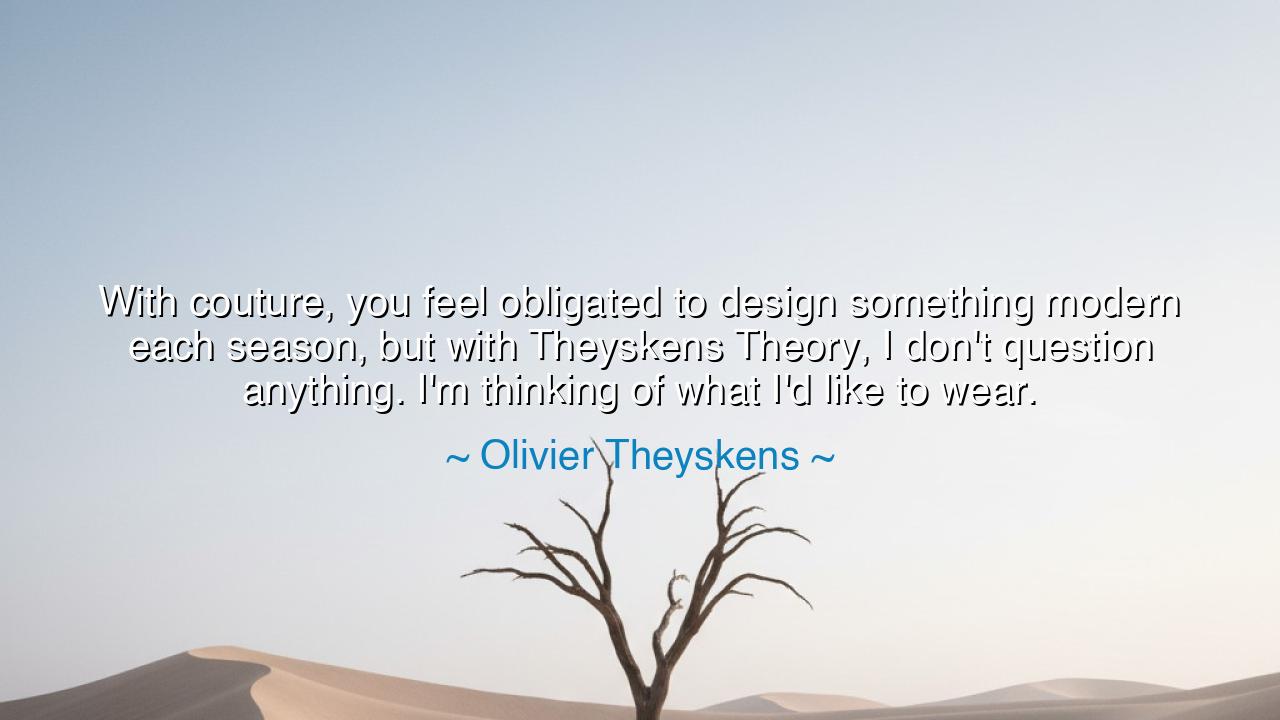
With couture, you feel obligated to design something modern each
With couture, you feel obligated to design something modern each season, but with Theyskens Theory, I don't question anything. I'm thinking of what I'd like to wear.






“With couture, you feel obligated to design something modern each season, but with Theyskens Theory, I don’t question anything. I’m thinking of what I’d like to wear.” — Olivier Theyskens
Thus speaks Olivier Theyskens, the quiet craftsman of the modern age, whose hands shape fabric yet whose heart shapes philosophy. In this reflection, he reveals a truth known to the wise in every art — that the highest form of creation is freedom, and that authenticity is a rarer jewel than innovation. When he contrasts couture with Theyskens Theory, he does not merely speak of fashion; he speaks of the struggle between the expectations of the world and the voice of the soul.
In the realm of couture, as Theyskens tells us, one is bound by a sacred duty — to be modern, to astonish, to dazzle the eyes of the watching world. Each season demands reinvention, as though beauty itself were a flame that must be reborn again and again. This is the burden of the artist when he creates for others — the constant questioning, the restlessness, the fear of repetition. Yet when Theyskens turns to his own line, Theyskens Theory, he steps beyond that anxiety. “I don’t question anything,” he says — meaning, he has found peace in creating from the heart rather than from expectation. He simply asks, What would I like to wear? and in that question lies the liberation of the true artist.
For every creator must one day choose between pleasing the world and listening to the self. In youth, one strives to impress — to prove mastery, to satisfy the demands of fashion, of fame, of fleeting applause. But in maturity, the wise turn inward. They learn that to create sincerely, to craft from love rather than duty, is to align the outer work with the inner being. This is what Theyskens discovered: that real art flows not from the mind’s fear of being outdated, but from the soul’s calm assurance that beauty born of truth never goes out of style.
Consider the story of Vincent van Gogh, who lived not by the rule of the galleries, but by the rhythm of his own heart. In his lifetime, no one called his work “modern.” He did not paint for the fashion of his time, but for the light that burned inside him — the sunflowers, the skies, the restless fields that only he could see. He questioned nothing except his devotion to his craft. And though he was ignored in life, time itself bent to him, and his vision became immortal. So it is with all who create not for applause, but for authenticity — their work speaks across centuries.
In Theyskens’s words lies a deeper wisdom: that self-expression is the truest form of design. The artist who trusts his own instincts creates harmony between thought and act. Whether he makes clothing, music, or architecture, what matters is not the novelty of his work, but the honesty of his intention. A garment made in freedom carries more grace than a masterpiece forged in anxiety. To not question anything is not arrogance; it is faith — faith in one’s taste, one’s intuition, one’s inner compass.
Therefore, my children, learn this lesson well: the greatest design is the design of the self. Do not live by the seasons of the world, always chasing what is “modern” or “new.” Instead, dwell in what is true. Ask not, “What will others think of me?” but rather, “What would I like to wear — what kind of life would I like to live?” For when your actions, your words, and your creations flow from your own soul, they will never grow old.
Let your work, then, be born of simplicity and sincerity. Whether you shape cloth, build a home, or write a song, let it carry your spirit within it. Seek freedom over perfection, authenticity over applause. The world will always hunger for what is honest. And as Olivier Theyskens has shown, when one stops questioning and begins trusting, the art that emerges is not merely beautiful — it is alive.
Thus, the teaching endures: Create not to impress, but to express. For when you follow your own design, you join the lineage of all true creators — those who listened to the quiet voice within, and by doing so, reshaped the world without ever meaning to.






AAdministratorAdministrator
Welcome, honored guests. Please leave a comment, we will respond soon